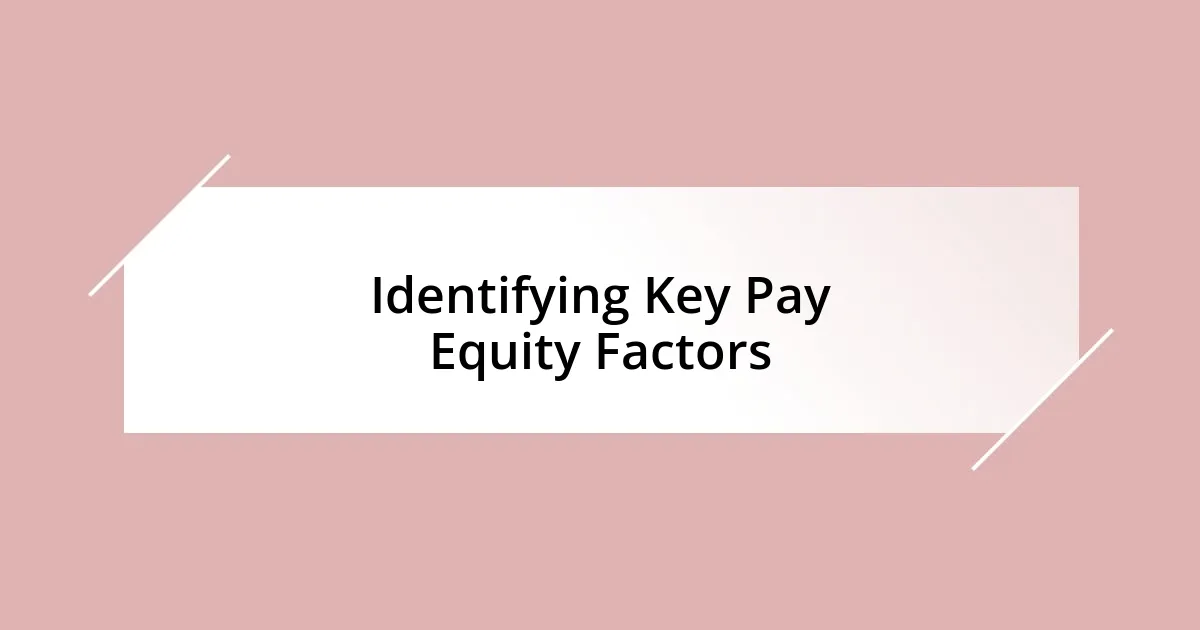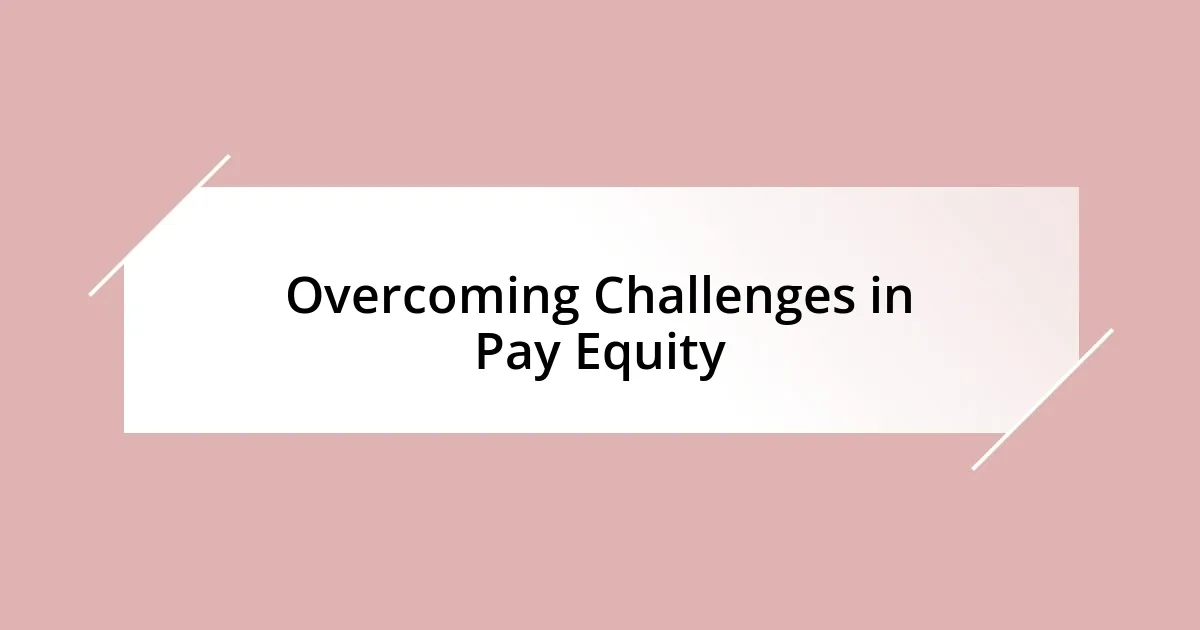Key takeaways:
- Personal experiences with pay disparity led to a deeper understanding of its emotional and professional impacts, emphasizing the need for transparency and open discussions.
- Identifying key factors of pay equity, such as job roles and negotiation practices, is essential for addressing disparities within organizations.
- Implementing salary audits and establishing clear salary ranges fosters an environment where employees feel empowered to advocate for fairness.
- Advocacy for fair pay practices relies on leadership support and the courage to facilitate open conversations about pay equity among colleagues.

Understanding Pay Equity Issues
Pay equity issues often stem from deeply entrenched societal norms and biases. I vividly remember working on a project where a male colleague and I had similar responsibilities and experience, yet he earned significantly more than I did. It left me wondering: how is it that our skills can be so easily overlooked based on gender?
Navigating conversations about pay can feel daunting. I once attended a meeting that aimed to address wage discrepancies, but the atmosphere was thick with tension and uncertainty. It made me think, how can we dismantle barriers if we’re too afraid to speak up? Reflecting on this made me realize the importance of fostering spaces where employees feel safe to voice their concerns.
When I choose to advocate for transparency in pay, I often think about the potential ripple effects. Imagine if every worker knew they were earning a fair wage for their contributions; would that not lead to greater job satisfaction and retention? It’s a powerful thought, and it paints a clearer picture of why addressing pay equity is not just a policy issue—it’s a heart issue.

Personal Journey with Pay Disparity
My experience with pay disparity often felt like navigating a minefield. There was a time in my career when I discovered I was making considerably less than my peers, despite having the same qualifications and tenure. The emotional weight of that realization was heavy; it made me question my worth within the organization and whether my contributions were valued as they should be.
I can recall a particularly eye-opening conversation with a colleague who shared their own struggles with inequitable pay. They expressed feelings of defeat and frustration, and I remember thinking, “Why should anyone have to feel this way?” This shared journey made it clear to me that pay disparity not only affects our financial lives but seeps into our professional identity and self-esteem. As we spoke, I felt a mix of anger and determination bubbling within me, realizing that this issue impacts not just individuals but the entire workplace culture.
As I continued to advocate for fairness, I began noticing the ripple effects of these conversations. It was surprising to see that once I took that initial step, others felt empowered to share their stories too. I think about the power of solidarity in these moments; when people come together, the collective voice becomes a force for change. It’s a reminder that addressing these disparities is not just a personal battle—it’s a team effort, and everyone plays a critical role.
| Experience | Emotion |
|---|---|
| Discovered significant pay gap | Heavy realization, questioning worth |
| Shared struggles with a colleague | Anger and determination |
| Advocating for fairness | Empowerment through teamwork |

Identifying Key Pay Equity Factors
Identifying pay equity factors can feel like unraveling a complex puzzle. I remember a situation where we collectively reviewed salary data by role and tenure. The stark differences in compensation based solely on gender left me feeling frustrated and confused. It wasn’t just numbers; it had a real impact on lives, families, and morale.
To truly understand pay equity, it’s crucial to consider a range of factors, including:
- Job Roles and Responsibilities: Are similar positions compensated similarly?
- Experience and Tenure: Does length of service or experience influence pay fairly?
- Educational Background: Are educational qualifications fairly valued across the board?
- Performance Reviews: Are promotions and raises based on merit and unbiased assessments?
- Negotiation Practices: Are all employees given equal opportunities and support in salary negotiations?
These factors serve as a foundation for assessing and understanding the intricate nature of pay equity. Each element plays its part in the larger story, shaping not just individual careers but also company culture and trust.

Strategies for Achieving Pay Equity
To achieve pay equity, a systematic approach is essential. I remember when my organization decided to conduct a salary audit. The process not only unearthed discrepancies but also fostered an environment where staff felt comfortable discussing their salaries. This transparency was a game-changer—how can we hope to resolve pay inequities without first shining a light on them?
Another effective strategy is to establish clear salary ranges for each position. I once worked at a place where this was implemented, and it was refreshing to see how it reduced ambiguity. When everyone knows the boundaries, it not only promotes fairness but also empowers employees to negotiate confidently. It gets me wondering—what if every organization adopted this practice?
Lastly, regular training on bias and equity for hiring managers and HR teams can make a significant impact. I recall attending a session where we dove deep into unconscious bias, and it was enlightening. I left the room feeling optimistic—small shifts in perspective can lead to better decision-making. How much more equitable could workplaces be if every leader was trained to recognize and mitigate bias?

Tools for Measuring Pay Equity
When it comes to measuring pay equity, leveraging data analysis tools is critical. I personally found platforms like PayScale and Glassdoor invaluable; they provided comprehensive salary insights tailored to specific job titles and regions. It was eye-opening to see how salary ranges differed across industries, and I often wondered how many companies missed these crucial insights.
Another tool I’ve come to appreciate is compensation benchmarking software. Using these tools, my team was able to compare our compensation packages against industry standards. I still remember the first time I reviewed the data; the disparity became painfully clear, and it lit a fire under us to take action. It’s astonishing to think that without these insights, many organizations might unknowingly perpetuate inequities.
Surveys can also be a great asset in understanding employee perceptions of pay equity. I’ve participated in several anonymous surveys that prompted discussions about compensation and satisfaction within our organization. Hearing firsthand how my colleagues felt about their pay illuminated gaps I hadn’t noticed before. Have you ever considered how powerful your employees’ voices can be in crafting a more equitable pay structure?

Overcoming Challenges in Pay Equity
Overcoming challenges in pay equity often requires a cultural shift within organizations. I found that when my team openly addressed pay disparity, resistance initially surfaced. But as conversations unfolded, I witnessed a transformation; more people began to step forward with their experiences, and the fear surrounding salary discussions slowly melted away. Isn’t it intriguing how vulnerability can strengthen workplace relationships?
Implementing change can also mean navigating tricky conversations with leadership. I remember the first time I presented pay equity concerns to my managers. My heart raced as I laid out the data. To my surprise, they didn’t react defensively; instead, they engaged collaboratively. It made me think—what if every employee felt empowered to advocate for fairness without fear?
It’s crucial to maintain momentum after initial discussions. I made it a point to follow up regularly on our pay equity initiatives. The ongoing dialogue kept the topic alive, reinforcing its importance in our corporate agenda. I believe a sustained commitment is key—after all, how can we hope to create lasting change without continuous effort?

Advocating for Fair Pay Practices
Advocating for fair pay practices isn’t just about crunching numbers; it’s about fostering a culture of transparency and inclusivity. I recall a meeting where I proposed an open forum for discussing salaries and benefits. The initial shock on my colleagues’ faces was palpable, but as we began to share our experiences, a sense of camaraderie emerged. It was then that I realized how often silence had allowed inequities to thrive.
As I pushed for fair pay initiatives, I encountered skepticism—was this really necessary, or merely a trend? I strategically shared stories of how inequitable pay had impacted not just individuals but the entire team morale. Witnessing my coworkers nod in agreement validated my belief that, sometimes, a heartfelt narrative can be more powerful than statistics. Have you ever felt a sudden shift in a group’s energy after someone spoke up about a shared struggle?
The importance of leadership support became clear during this journey. I became an advocate not just for myself but for those whose voices were often unheard. When I developed a proposal for regular pay audits and presented it to our executives, I felt an overwhelming sense of purpose. Their receptive attitude inspired me; it’s incredible to realize how one conversation can pave the way for institutional change. Isn’t it empowering to think that advocating for fairness can start with just one person’s determination?














